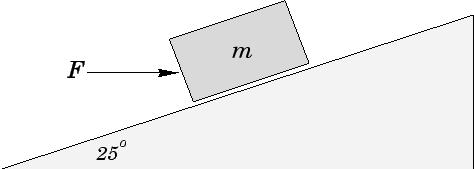

Answer: Only that component of the applied force which is
parallel to the incline has any influence on the block's motion: the normal
component of the applied force is canceled out by the normal reaction
of the incline. The component of the applied force acting up the
incline is
![]() . Likewise, the component of the block's
weight acting down the incline is
. Likewise, the component of the block's
weight acting down the incline is
![]() . Hence, using
Newton's second law to determine the acceleration
. Hence, using
Newton's second law to determine the acceleration ![]() of the block
up the incline, we obtain
of the block
up the incline, we obtain